
© Railway Wonders of the World 2012-


Brighton’s Electric Railway
The First Electric Line in Great Britain
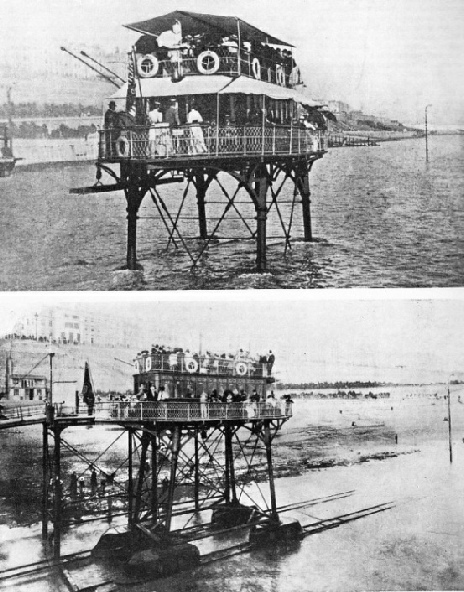 ON August 3, 1883, the first public electric railway in England began to run. This was a line, about a quarter of a mile long, which extended along the sea front at Brighton, from the Aquarium to the Old Chain Pier. Fifty-
ON August 3, 1883, the first public electric railway in England began to run. This was a line, about a quarter of a mile long, which extended along the sea front at Brighton, from the Aquarium to the Old Chain Pier. Fifty-
A RAILWAY ON STILTS. A remarkable extension of Volk’s Electric Railway from Brighton to Rottingdean was opened in 1896. The carriages were carried about 23 ft above the rail level. The vehicle weighed about thirty-
That it was some years in advance of its time is shown by the fact that it antedated the City and South London Railway, the world’s oldest tube railway, by about seven years.
The undertaking was the idea of Mr. Magnus Volk, who has remained associated with it for over fifty years. Mr. Volk’s interests included pioneer work in connexion with the electric telegraph, the telephone, electric lighting, and electrically-
The Volk’s Electric Railway has carried over forty million people since its inception. In its present extended form it runs along the sea front near the Palace Pier to Black Rock, a distance of about one and a half miles. The track is slightly elevated above the beach, and at high tide it runs over the sea -
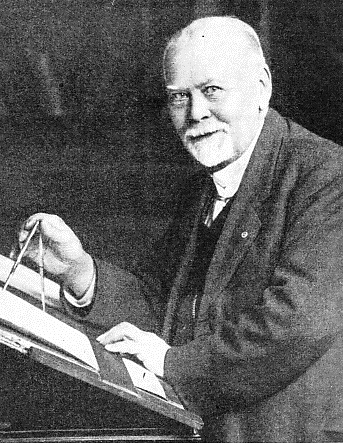 The official opening day was August 3, 1883. During August Bank Holiday of that year, when the line was in operation for eleven hours, the single car in its possession is said to have carried about a thousand passengers and to have run an aggregate of fifty miles. As originally constructed, the gauge of the railway was only two feet. The small four-
The official opening day was August 3, 1883. During August Bank Holiday of that year, when the line was in operation for eleven hours, the single car in its possession is said to have carried about a thousand passengers and to have run an aggregate of fifty miles. As originally constructed, the gauge of the railway was only two feet. The small four-
THE INVENTOR of the famous Electric Railway at Brighton, Mr. Magnus Volk. Mr. Volk has also carried out research work in connexion with the electric telegraph, the telephone, electric lighting and electrically driven motor-
Despite gloomy predictions as to its impracticability, the railway was a popular success from the first. The announcement of the opening of Volk’s Electric Railway attracted large crowds of spectators, the more especially as it was expected that the car would not work. In this the crowd was disappointed, as when started by the Mayor, the car with a heavy load moved away easily and without a hitch.
Permission for the operation of the line had originally been granted for only six months, but this period was speedily extended. In the meantime the success of the undertaking had given rise to much local antagonism, especially on the part of the cabmen, boatmen, and persons engaged in the hay and corn-
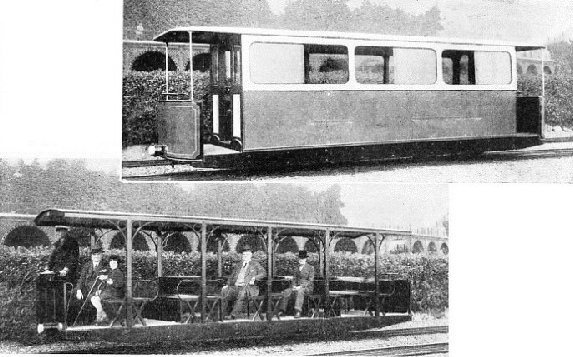
SUMMER AND WINTER ROLLING-
The original permanent way was composed of flat-
From its earliest days, the railway attracted considerable attention in the press. A contemporary account refers to “the electric car, which (so Mr. Volk informs us) is a model of the interior of the deck saloon on a steam yacht; constructed of solid mahogany, plate-
This description is not that of the first vehicle, which, as will be seen from the illustration below, was hardly of so ornate a character. That was, however, scarcely to be expected, since the car, together with the dynamo and motor, was built, the generating plant installed, and the track laid, within eighteen days. This period must be regarded as remarkably short, when the pioneer nature of the whole work is borne in mind.
Despite the opposition of interested parties who feared competition, the Brighton Corporation -
In its present form the line, which is mostly single track, though equipped with adequate passing places, is laid on the 2 ft 8½ in gauge, being the only line in the kingdom constructed to that dimension.
The longitudinal sleepers have given place to the more customary cross sleepers, the running rails are of the Vignolles pattern, and the conductor third rail of channel section steel on earthenware insulators.
The original little vehicle has been replaced by a total of ten cars, some closed and some open. The latter are known as “toast racks”, a design that greatly facilitates quick entrance and exit. The seating capacity of each car is thirty-
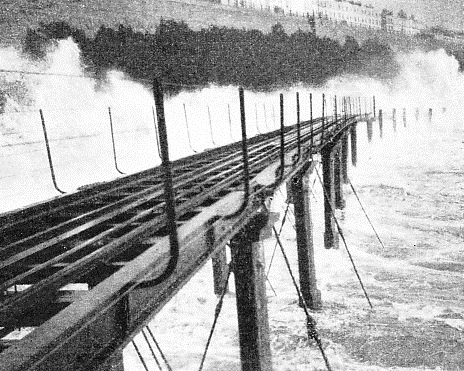
FORTY MILLION PEOPLE have been carried on Volk’s Electric Railway since its inception. The picture shows a section of the track undergoing a fierce attack by a rough sea, through which the cars frequently have to run during the winter months.
In spite of the small size of the undertaking, the line carries an average of well over a million passengers a year. It is a point of pride with the management that the five-
The generating plant has officially been described as being situated “in a cave in the sea wall”. The main equipment consists of a 90 hp motor generator converting the Corporation electric supply of 460 volts direct current to the track voltage of 160. There is also a small reserve 20 hp set. Two types of motor are in use, three care being of the original Siemens link belt-
The Rottingdean Extension, which ran from Brighton to Rottingdean, was one of the most remarkable railways ever built. For, while Volk’s Electric Railway ran -
This extension, which received Parliamentary sanction in 1893, can best be described as a line whose tracks were laid on the shore, so that they were submerged at high tide, while the car, which resembled the midship portion of a Thames pleasure steamer, was supported by a combination of stilts and runners. At the time of its inauguration the Rottingdean line was generally known as the “railway on stilts”. It was planned to begin near Paston Place, and thence to proceed “along the beach and foreshore on the level between high and low water mark at a distance of about 100 yards from the cliff to the village of Rottingdean, terminating at a point on the seashore immediately to the westward of Rottingdean Gap”. A jetty or landing stage was provided at the Rottingdean end. This extended into the sea a distance of about 200 ft.
The idea underlying this unique method of construction was that by taking the line a sufficient distance from the cliffs “a fine view of them would be obtained by the passengers”. The gauge of the Brighton and Rottingdean Seashore Electric Tram-
The length of the line was about two and three quarter miles, and at high tide the car moved through 15 ft of water. The work of construction began immediately Parliamentary sanction had been obtained, and was carried on continuously, despite morning and evening tides. During the winter in which operations were undertaken, construction was greatly hampered by intense cold, which caused the sea water to freeze on the groynes that are so characteristic a feature of this part of the South Coast.
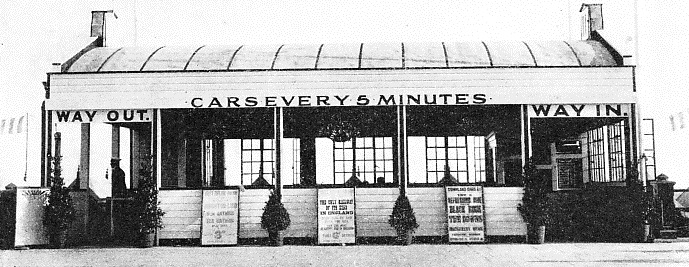
THE AQUARIUM STATION on Volk’s Electric Railway. There are three stations on the line, which carries an average of over a million passengers a year.
It would, of course, have been out of the question to lay the tracks on wooden sleepers, and, as the bed-
The car, which had accommodation for about 160 passengers, was 50 ft long and 22 ft wide. According to a story current at the time, the Corporation of Brighton refused to grant a licence to the undertaking unless the structure carried a lifeboat. The vehicle was accordingly provided with a lifeboat to meet the requirement.
The four legs, or stilts, on which the vehicle was supported were steel tubes, through which passed shafts acting on the wheels. Two of these shafts, which were actuated by bevel gearing, conveyed motion to the wheels, while the other two worked the brakes. Each of the legs terminated in a four-
After the approval of the Board of Trade had been obtained, the line was opened in September, 1896. It attracted considerable attention in the Press. One journal, which referred to the attractions of “a coasting trip, without the terrible internal disturbances by which such aquatic jaunts are not infrequently accompanied”, characterized the undertaking as “about as fin-
Unfortunately, these predictions failed to materialize, and the Brighton and Rottingdean Tramroad itself had only a short life. Shortly after its opening it was badly damaged by the gale that destroyed the Old Chain Pier. The promoters were, however, not daunted by a mishap on the possibility of which they had no doubt reckoned, and the line was repaired and reopened. Changes in the seashore, however, eventually put a stop to working, and the track had to be taken up.
So ended the life of a railway that remains unique in the history of transport. But it has been pointed out by Mr. Volk that the construction was of a purely experimental nature, and that if the money had been available for an improved type of car, much better results would have been obtained.
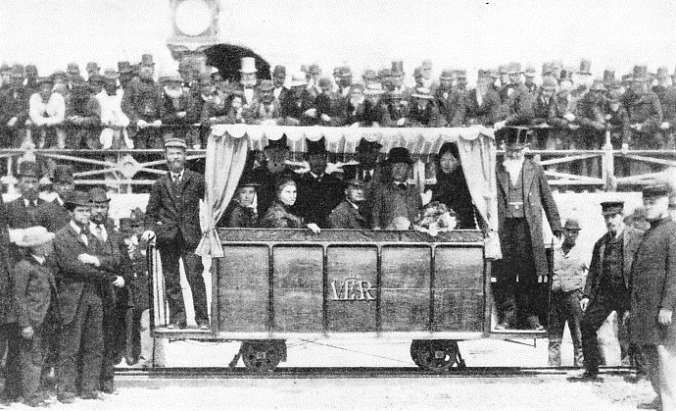
THE OPENING CEREMONY of Volk’s Electric Railway on August 3rd, 1883, attracted great interest. The car was started by the Mayor, who travelled on the first journey. The inventor, Mr. Magnus Volk, can be seen as conductor at one end of the car.
Read more on “Electric Power on the Grand Scale”, “Electric Railways” and “Electric Traction” on this website.